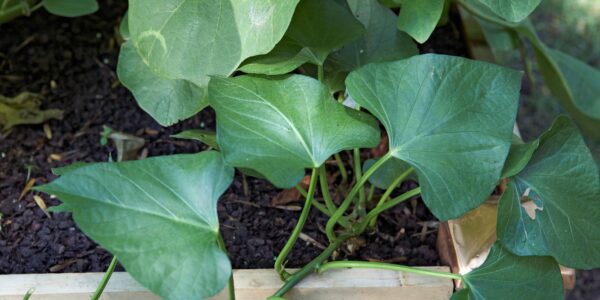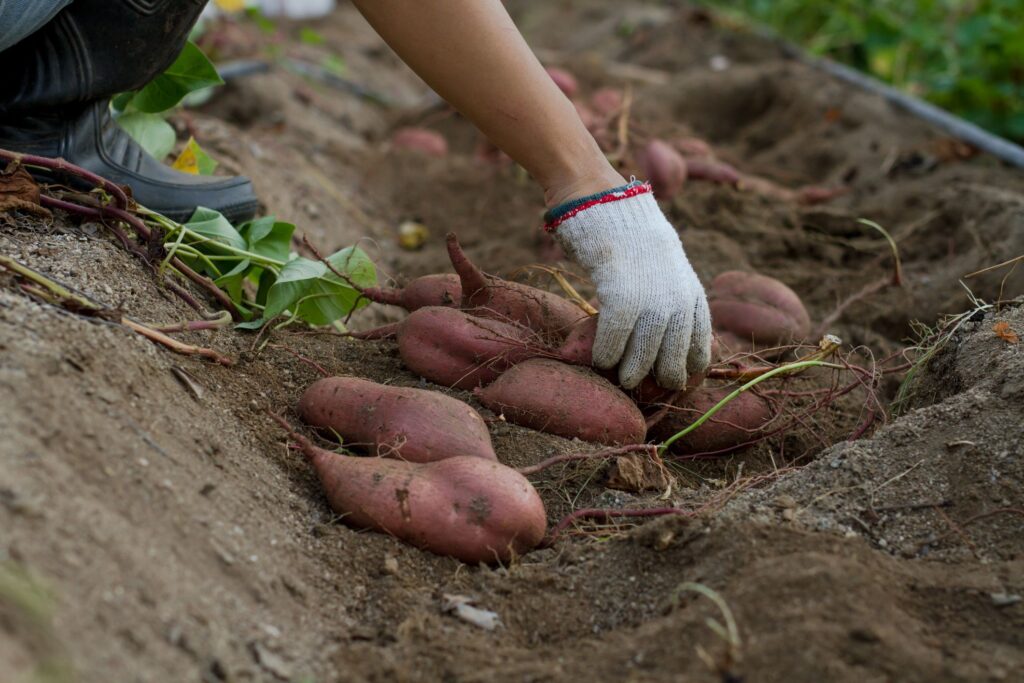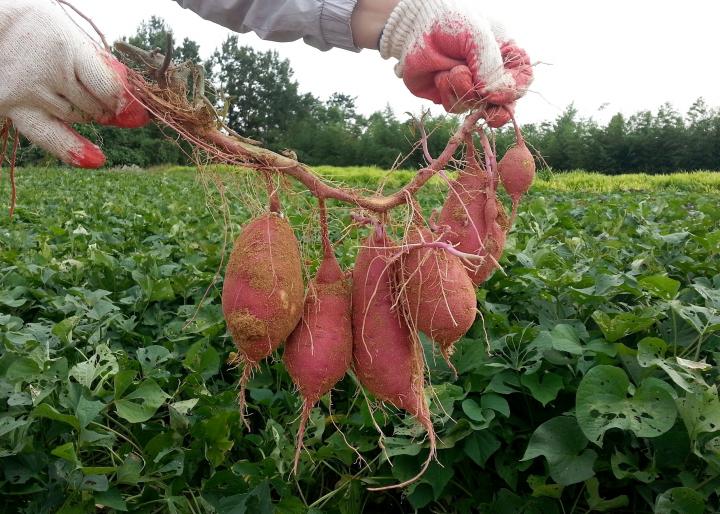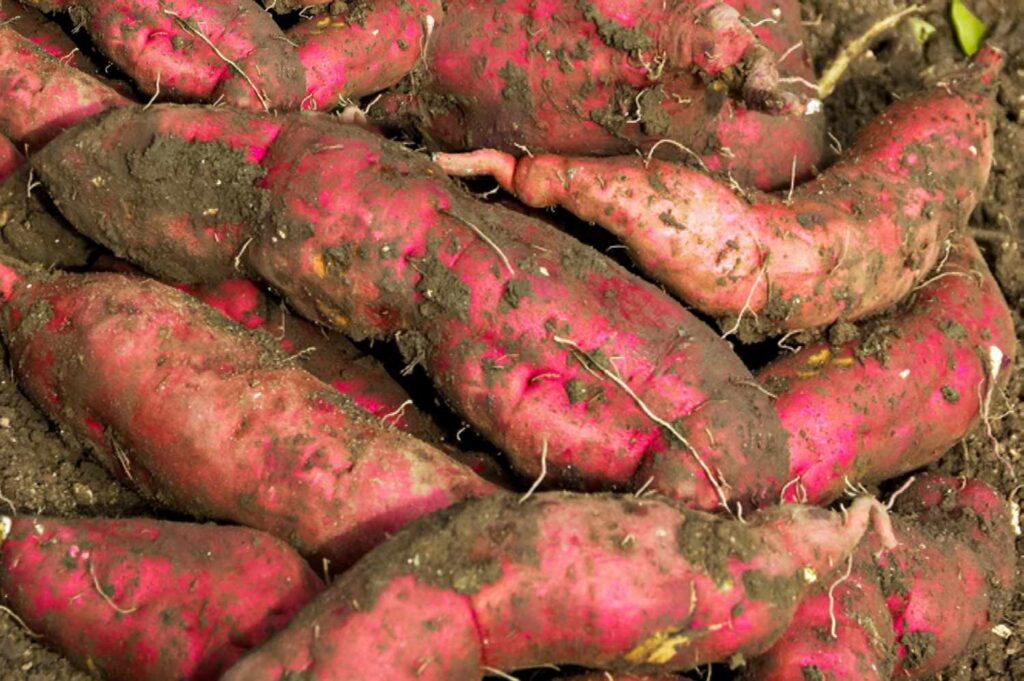Sweet Potato Cultivation: Tips for a Bountiful Harvest

Sweet potato cultivation offers a rewarding experience for farmers and gardeners. This nutrient-rich crop is not only versatile but also relatively easy to grow.
Sweet potatoes thrive in warm climates and provide a rich source of vitamins and fiber. Cultivating sweet potatoes involves selecting the right soil, ensuring proper spacing, and providing adequate water. This guide will walk you through the essential steps to grow your own sweet potatoes successfully.
Whether you are a novice gardener or a seasoned farmer, understanding the basics of sweet potato cultivation can help you achieve a bountiful harvest. Let’s explore the key techniques and tips for cultivating this delicious and nutritious crop.
Introduction To Sweet Potato Cultivation
Sweet potato cultivation is a rewarding endeavor. This crop is known for its resilience and nutritional value. Easy to grow, sweet potatoes thrive in various climates. They require minimal care and offer bountiful yields. Let’s explore the importance and nutritional benefits of sweet potatoes.
Importance Of Sweet Potatoes
Sweet potatoes hold significant importance in agriculture. They are a staple food in many countries. Farmers appreciate their versatility and high yield. Here are some key points:
- High Yield: Sweet potatoes produce large quantities per acre.
- Drought Resistance: They can withstand dry conditions.
- Soil Improvement: Their vines help prevent soil erosion.
- Economic Value: They provide a source of income for farmers.
Nutritional Benefits
Sweet potatoes are packed with nutrients. They offer numerous health benefits. Here is a breakdown of their nutritional value:
| Nutrient | Benefit |
|---|---|
| Vitamin A | Improves vision and immune function |
| Vitamin C | Boosts immune health and skin quality |
| Fiber | Supports digestive health |
| Potassium | Regulates blood pressure |
Including sweet potatoes in your diet can enhance overall health. Their rich nutrient profile makes them a valuable addition to meals. They are also versatile in cooking, from fries to pies.
Selecting The Right Variety for Sweet Potato Cultivation
Selecting the right sweet potato variety is crucial for a successful harvest. The variety you choose must match your climate, soil type, and market demand. Let’s explore some popular varieties and climate considerations to make an informed decision.
Popular Varieties
Sweet potatoes come in various varieties, each with unique characteristics. Here are some popular choices:
- Beauregard: This variety has a high yield and deep orange flesh. It is versatile and sweet.
- Jewel: Known for its copper skin and moist texture. Ideal for baking.
- Covington: A favorite in the U.S. with rose-colored skin and orange flesh. It stores well.
- Japanese Sweet Potato: Purple skin with white flesh. It has a nutty flavor and is very sweet.
Each variety has its own benefits and growth requirements. Choose one that suits your needs.
Climate Considerations
Climate plays a significant role in sweet potato cultivation. Here are key factors to consider:
| Climate Factor | Optimal Conditions |
|---|---|
| Temperature | 21°C to 26°C (70°F to 80°F) |
| Rainfall | 750 to 1,000 mm annually |
| Frost Sensitivity | Very sensitive; avoid frost |
| Sunlight | Full sun, at least 6 hours daily |
Ensure your climate conditions align with the variety you select. This will improve your chances of a bountiful harvest.
Preparing The Soil
Preparing the soil is a crucial step in sweet potato cultivation. The right soil conditions ensure healthy growth and a bountiful harvest. Let’s explore the best practices for soil preparation to set your sweet potato plants up for success.
Soil Types
Sweet potatoes thrive in well-drained, sandy loam soils. These soils have the right balance of sand, silt, and clay.
The ideal soil should:
- Have good drainage
- Be slightly acidic (pH 5.8 to 6.2)
- Contain organic matter
Avoid heavy clay soils as they retain too much water. This can lead to root rot.
Soil Preparation Techniques
Preparing the soil involves several steps to ensure it is ready for planting.
- Testing the Soil: Conduct a soil test to determine pH and nutrient levels. Adjust as needed.
- Clearing the Area: Remove weeds, rocks, and debris from the planting area.
- Loosening the Soil: Use a tiller or garden fork to break up the soil to a depth of 12 inches. This improves root penetration.
- Adding Organic Matter: Incorporate compost or well-rotted manure into the soil. This enhances fertility and structure.
- Creating Ridges: Form raised beds or ridges about 8-12 inches high. This promotes better drainage and aeration.
By following these soil preparation techniques, you create an optimal environment for your sweet potatoes to thrive.
Planting Sweet Potatoes
Sweet potatoes are a nutritious and versatile crop. They are relatively easy to grow and can thrive in various climates. This guide will help you understand the best practices for planting sweet potatoes. Let’s dive into the details.
Planting Methods
There are several methods to plant sweet potatoes. The most common methods include planting slips, using tubers, and direct seeding.
- Planting slips: Slips are young shoots grown from mature sweet potatoes. These are the most popular method for planting.
- Using tubers: Planting whole or cut tubers directly in the soil. This method is less common but can be effective.
- Direct seeding: This involves planting seeds directly into the ground. It is the least common method.
Planting slips is recommended for beginners. It ensures better growth and higher yields.
Optimal Planting Time
Timing is crucial for successful sweet potato cultivation. Planting sweet potatoes at the right time ensures healthy growth and a bountiful harvest.
| Climate | Optimal Planting Time |
|---|---|
| Warm climates | 2-3 weeks after the last frost |
| Cool climates | 3-4 weeks after the last frost |
Ensure the soil temperature is at least 60°F (16°C) before planting. Warmer soil promotes better root development.
Planting sweet potatoes is a rewarding activity. Follow these methods and timing recommendations to achieve a successful harvest.
Watering And Irrigation for Sweet Potato Cultivation
Proper watering and irrigation are vital for sweet potato cultivation. Ensure soil remains consistently moist but not waterlogged for optimal growth. Regular, deep watering supports strong root development.
Sweet potato cultivation requires proper watering and irrigation practices to ensure healthy growth. Both overwatering and underwatering can lead to problems. Therefore, understanding the right watering needs and efficient irrigation techniques is essential.
Watering Needs
Sweet potatoes need consistent moisture for optimal growth. They require about 1 inch of water per week. This includes both rainfall and irrigation. It is crucial to maintain even soil moisture, especially during the growing season. Dry soil can stress the plants, affecting the yield.
| Growth Stage | Water Requirement |
|---|---|
| Planting to Establishment | Keep soil moist but not soggy |
| Mid-Growth | 1 inch of water per week |
| Pre-Harvest | Reduce watering |
Efficient Irrigation Techniques
Implementing efficient irrigation techniques can save water and improve plant health. Here are some recommended methods:
- Drip Irrigation: Provides water directly to the plant roots. Reduces water loss due to evaporation.
- Soaker Hoses: Delivers water slowly and evenly. Ideal for maintaining consistent soil moisture.
- Mulching: Helps retain soil moisture. Reduces the frequency of irrigation.
Consider using a timer for your irrigation system. This ensures that your sweet potatoes receive the right amount of water. Also, water your plants early in the morning. This minimizes water evaporation and allows plants to absorb moisture effectively.
By following these watering and irrigation practices, you can ensure healthy sweet potato growth and a bountiful harvest.
“`

Fertilizing Sweet Potatoes
Fertilizing sweet potatoes is crucial for healthy growth and a good yield. The right fertilizer ensures the plants get the nutrients they need. This section will cover the nutrient requirements and the choice between organic and chemical fertilizers.
Nutrient Requirements
Sweet potatoes need a balanced supply of nutrients. The main nutrients are nitrogen (N), phosphorus (P), and potassium (K). Each nutrient has a specific role:
- Nitrogen: Helps with leafy growth.
- Phosphorus: Supports root development.
- Potassium: Boosts overall plant health.
A soil test can help determine the exact nutrient needs. Sweet potatoes also benefit from secondary nutrients like calcium and magnesium. Ensuring the right balance is key to a successful crop.
Organic Vs. Chemical Fertilizers
Both organic and chemical fertilizers can be used for sweet potatoes. Each type has its own benefits and drawbacks.
| Fertilizer Type | Benefits | Drawbacks |
|---|---|---|
| Organic |
|
|
| Chemical |
|
|
Choosing between organic and chemical fertilizers depends on your goals. For an eco-friendly approach, organic fertilizers are the way to go. Chemical fertilizers are ideal for quick nutrient boosts. Always follow the recommended application rates.
Pest And Disease Management
Sweet potato cultivation can be a rewarding venture. Yet, managing pests and diseases is crucial for a healthy crop. Effective management ensures high yields and quality produce. Here are some strategies to keep your sweet potatoes pest and disease-free.
Common Pests
Several pests can affect sweet potato plants. Here are the most common ones:
- Sweet Potato Weevil: These insects bore into the tubers and stems, causing significant damage.
- Flea Beetles: Tiny beetles that create small holes in leaves, reducing photosynthesis.
- Aphids: Small insects that suck plant sap, leading to stunted growth and yellow leaves.
- Cutworms: These pests cut young plants at the soil line, killing them.
Regular monitoring and early detection help manage these pests effectively.
Disease Prevention
Diseases can severely impact sweet potato yields. Here are some prevention tips:
- Crop Rotation: Rotate sweet potatoes with non-host crops to break pest and disease cycles.
- Resistant Varieties: Plant disease-resistant varieties to reduce the risk of infection.
- Proper Spacing: Ensure adequate spacing between plants for good air circulation.
- Clean Planting Material: Use certified disease-free slips for planting.
These practices can help prevent the spread of diseases in sweet potato fields.
Integrated Pest Management (ipm)
IPM combines multiple strategies for effective pest control. It involves:
- Regular monitoring of pest levels.
- Using biological controls like beneficial insects.
- Applying chemical pesticides only when necessary.
IPM minimizes damage while promoting a healthy crop environment.

Harvesting Techniques
Harvesting sweet potatoes correctly is crucial for a good yield. Knowing the right time and methods ensures the best quality and taste. Let’s explore the signs of maturity and proper harvesting methods.
Signs Of Maturity
Sweet potatoes need time to mature. Look for these signs:
- Leaves start to yellow.
- Vines begin to die back.
- The skin is firm and smooth.
- Roots have reached their full size, usually around 3-4 months after planting.
Proper Harvesting Methods
Follow these steps to harvest sweet potatoes properly:
- Stop watering the plants one week before harvest.
- Use a spading fork to loosen the soil around the plants.
- Lift the roots carefully to avoid damage.
- Shake off excess soil from the roots.
- Handle sweet potatoes gently to prevent bruising.
After harvesting, cure the sweet potatoes for better taste and longer storage.
Place them in a warm, humid area for 10 days. Then, store them in a cool, dry place.
By following these steps, you will ensure a bountiful and tasty sweet potato harvest.
Post-harvest Handling
Proper post-harvest handling is crucial in sweet potato cultivation. It ensures the best quality and extends shelf life. This section covers essential aspects such as curing and storage tips.
Curing Sweet Potatoes
Curing sweet potatoes is the first step after harvesting. It helps heal any cuts and toughens the skin. This process also improves flavor and sweetness.
Follow these simple steps for effective curing:
- Temperature: Maintain a temperature of 85°F (29°C).
- Humidity: Ensure 85-90% relative humidity.
- Duration: Cure for 4-7 days.
During curing, store sweet potatoes in a well-ventilated area. Use fans if necessary to keep air circulating. Avoid exposure to direct sunlight. This can cause uneven curing and spoilage.
Storage Tips
After curing, move sweet potatoes to a cool, dark place for storage. Proper storage extends their shelf life and maintains quality.
Consider these tips for optimal storage:
- Temperature: Store at 55-60°F (13-15°C).
- Humidity: Maintain 85-90% relative humidity.
- Ventilation: Ensure good air circulation to prevent rot.
- Containers: Use wooden crates or baskets for storage.
Avoid storing sweet potatoes in the refrigerator. Cold temperatures can cause hard centers and affect taste. Check stored sweet potatoes regularly for signs of spoilage. Remove any that show mold or rot to protect the rest.
By following these tips, you can enjoy your sweet potatoes for months. They will retain their flavor and nutritional value.
Marketing And Selling
Sweet potato cultivation can be profitable. But how do you get your produce to the market? Understanding the best ways to market and sell your sweet potatoes is key. This section will guide you through the options available to maximize your profits.
Local Markets
Local markets are a great starting point for selling sweet potatoes. Farmers’ markets and roadside stands are popular venues.
- Farmers’ Markets: You can set up a stall and sell directly to customers. This allows you to build relationships and get feedback.
- Roadside Stands: Setting up a stand near busy roads can attract travelers. Ensure your stand is visible and attractive.
Packaging is important. Use simple but appealing packaging. Label your sweet potatoes with your farm’s name and contact information.
Pricing should be competitive. Research local prices and set yours accordingly. Offer discounts for bulk purchases to attract more buyers.
Online Sales
Online sales can expand your customer base. You can reach people beyond your local area.
- Create a Website: A simple website can showcase your products. Include high-quality photos and product descriptions.
- Use Social Media: Platforms like Facebook and Instagram can help you promote your sweet potatoes. Post regularly and engage with your followers.
- Join Online Marketplaces: Sites like Etsy or Amazon can give you access to a larger audience. Ensure you follow their guidelines for listing products.
Shipping is crucial. Ensure your sweet potatoes are packed securely to avoid damage. Offer different shipping options to cater to various needs.
Communicate with your customers. Respond to queries promptly and provide excellent customer service. Good reviews can boost your online reputation.
By using both local and online sales strategies, you can maximize your profits and reach a wider audience.

Frequently Asked Questions
How To Start Sweet Potato Cultivation?
To start sweet potato cultivation, select a sunny location with well-drained soil. Begin by planting slips or vine cuttings.
What Is The Best Soil For Sweet Potatoes?
Sweet potatoes thrive in sandy, well-drained soil with a pH between 5. 5 and 6. 5. Ensure the soil is fertile.
How Often Should Sweet Potatoes Be Watered?
Water sweet potatoes once a week, providing about an inch of water. Keep the soil consistently moist but not waterlogged.
When To Harvest Sweet Potatoes?
Harvest sweet potatoes 90 to 120 days after planting. Look for yellowing leaves as a sign of maturity.
Conclusion of Sweet Potato Cultivation
Sweet potato cultivation offers many benefits. It’s easy to grow and nutritious. Farmers can enjoy good yields with proper care. These hardy plants thrive in various climates. They also improve soil health. Start your sweet potato garden today. Enjoy fresh, homegrown produce.
Your family will love the taste. Happy planting!




Leave a Reply